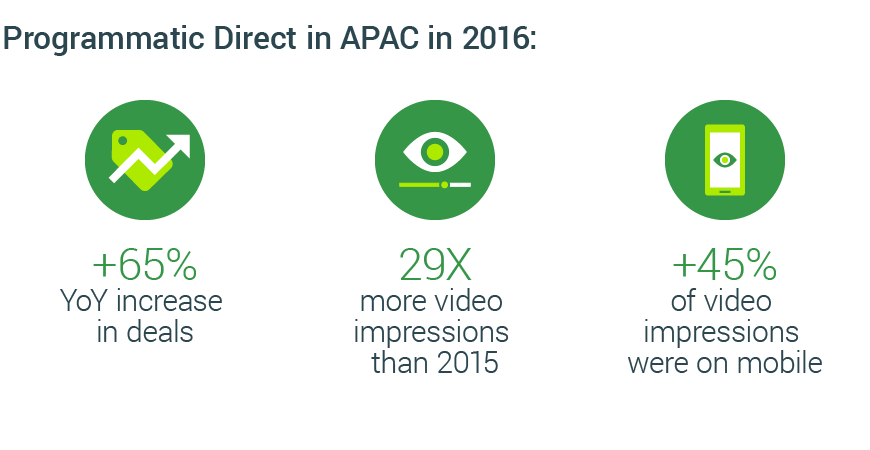In the ever-changing landscape of digital advertising, marketers need to find more efficient and effective ways to reach their audiences. Programmatic advertising allows brands to use audience insights and technology to tailor messages to the right person, at the right moment, in the right context.
Buyers and sellers have embraced Programmatic Direct because it offers the control of traditional reservations, with the efficiency, targeting, and reach of programmatic buying. This approach gives ad buyers direct access to efficient and precise media buying while helping sellers create sustainable businesses with advertising. For the second consecutive year, the number of Programmatic Direct deals on Google Ad Manager1 more than tripled in 2016, and we expect them to keep growing as publishers and advertisers continue to realize that automated transactions allow digital advertising to be executed in a more effective and efficient way.
The growth is even more pronounced in APAC. According to Google Ad Manager data from January 2015 to December 2016, impressions delivered through Programmatic Direct deals in APAC grew more than 65% YoY in 2016 (ahead of the Americas, where the number was a little over 50%), with 29X more Programmatic Direct video impressions than 2015. Not only that, more than 45% of those impressions were on mobile.
The top five countries in the world with the fastest-growing Programmatic Direct adoption rates are in APAC: Indonesia, South Korea, Malaysia, Taiwan, and India. Indonesia had the highest Programmatic Direct growth rate among APAC Countries in 2016 at over 6X, followed by both South Korea and Hong Kong, each at over 3X. And Japan ran the most Programmatic Direct impressions in 2016, followed by China and Australia.

Advertisers and publishers in the region are realizing that Programmatic Direct not only connects the world of traditional media reservations with the power of real-time programmatic bidding, but it also uses technology to allow advertisers to reach their target audience easily with greater precision on brand-safe inventory (the 1:1 relationship results in stronger engagement and better performance). For publishers, it means they are generating stronger sales partnerships with brand-safe ads from advertisers they trust, as well as greater automation and scale, creating greater operational efficiency in sales.
Three programmatic trends in APAC
Trend #1: Mobile is driving growth
In 2016, impressions served globally on mobile devices grew over 5.5X faster than on desktop. The growth has been explosive: In APAC, there was over 150% growth in Programmatic Direct mobile impressions, followed by EMEA at 120% growth.
In both South Korea and Indonesia, mobile impressions grew more than 15X in 2016. And mobile impressions tripled in more than eight APAC countries measured: Australia, China, Hong Kong, India, Indonesia, Malaysia, South Korea, and Taiwan.
“India, our biggest market, has seen the fastest adoption of programmatic on mobile, thanks to advertisers who believe in our platform. They are buying TrueCaller’s in-app inventory programmatically to deliver, not only our high-impact roadblocks, but also our in-app native ad units. It’s very nature—transparency and effectiveness—backs our belief that Programmatic Direct on mobile will take center-stage in 2017—an event that every brand in India is looking forward to,” said Ted Nelson, chief commercial officer at TrueCaller.
"It was essential that we could find and buy our target audience on premium publishers, big or small, and connect via Google Marketing Platform pipes for simpler activation on both sides."
Trend #2: Greater efficiency across screens
Programmatic Guaranteed offers the control of traditional reservations with the efficiency, targeting, and reach of programmatic buying. Programmatic Guaranteed provides advertisers access to the publisher’s most exclusive inventory, and this year it was the fastest growing deal, gaining great momentum in the region. This year, there were 3X publishers and 6X advertising partners who transacted 300+ deals, with India and Australia serving the most Programmatic Guaranteed impressions in APAC in 2016.
"As viewing habits have continued to shift across screens, Programmatic Guaranteed has been a crucial tool for us to deliver a truly holistic video approach to our clients. To realize this, it was essential that we could find and buy our target audience on premium publishers, big or small, and connect via Google Marketing Platform2 pipes for simpler activation on both sides. We have found this type of deal eliminates the friction and inefficiency of IOs, breaks down siloed platforms for a unified view, and ultimately boosts reach to build brands,” said Tom Fryett, director of video at Omnicom Media Group.
Trend #3: More immersive storytelling
Video emerged as the fastest-growing format in programmatic deals across platforms and throughout most markets. Video has proved to be an efficient way to reach audiences with immersive storytelling, giving publishers and broadcasters more opportunities to monetize their premium inventory.
In 2016, Programmatic Direct video impressions grew more than 300% in the Americas and 200% in EMEA. The greatest growth, however, was in APAC, with Programmatic Direct video impressions growing to 29X the impressions in 2015. Not only that, more than 45% of those impressions were on mobile. Programmatic Direct video impressions grew 6.5X faster than display in 2016, and India and Australia are leading the way with total Programmatic Direct video impressions served in the APAC region.
The fastest adopters of Programmatic Direct video in the world are all in our region: India, China, South Korea, Japan, and Taiwan. China is ramping up Programmatic Direct video impressions the fastest of all countries in the APAC region.
Where is the industry going?
As the data shows, Programmatic Direct is becoming the way that advertisers and publishers are choosing to do digital advertising. We predict that the number of deals will keep growing as more advertisers and publishers will choose to conserve resources and streamline the sales process.






